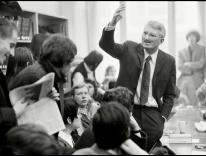Lent, like Advent, is a season of preparation and expectation. Officially, it ends on Holy Thursday, but Holy Saturday—the day between Jesus' public defeat and his quiet triumph—is the greatest day of expectation in the Christian calendar. For the church, this expectation is full of gladness: we know how the story ends. For Christ's first followers, though, the day brought more despair than hope. If he was truly dead, they had been fools. Had they been taken in, or had they simply misunderstood what he was up to? Either way, they were now at loose ends. How could they just go back to their old lives, seeing what they had seen, hoping for what they had hoped for? But that may have seemed to some of them like the best they could do, and it wasn't much. The greater the hope, the greater the disappointment: their old lives would now seem terribly empty, hollowed out by an extraordinary but finally meaningless interlude.
The empty tomb saved them from that emptiness, but on this one day it is worth considering their brief predicament. Most of us have known, at least once, the kind of loss or disappointment that stuns a person into silence. After the silence comes a question: What now? Not the exasperated "What now?" that means, "I thought I'd seen it all," but the desolate "What now?" that means, "What could possibly happen now, or ever, that would make sense of what has already happened?"
Meanwhile, Jesus is not lying in his death shroud waiting to be reanimated. He's busy. There are many great paintings of the Harrowing of Hell, but only a few great poems. One of them is by Denise Levertov. For copyright reasons, I won't include the whole thing here, but it's easy to find and well worth reading. The poem first describes the moment of rescue:
the merciful dead, the prophets,
the innocents just His own age and those
unnumbered others waiting here
unaware, in an endless void He is ending
now, stooping to tug at their hands,
to pull them from their sarcophagi,
dazzled, almost unwilling.
Then the poem turns toward the...what should we call it? Not the Ascent—that word is already taken for Christ's final return to the Father. Nevertheless, before he could ascend into heaven, he had to climb back to earth, and meet again with his disappointed friends, and show them that they had hoped too little, not too much. To do this, he had "to break / through earth and stone of the faithless world":
back to the cold sepulchre, tearstained
stifling shroud; to break from them
back into breath and heartbeat, and walk
the world again, closed into days and weeks again,
wounds of His anguish open, and Spirit
streaming through every cell of flesh
so that if mortal sight could bear
to perceive it, it would be seen
His mortal flesh was lit from within, now,
and aching for home.
You can read all of "Ikon: The Harrowing of Hell" here.
